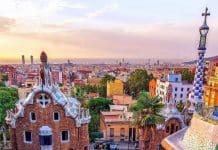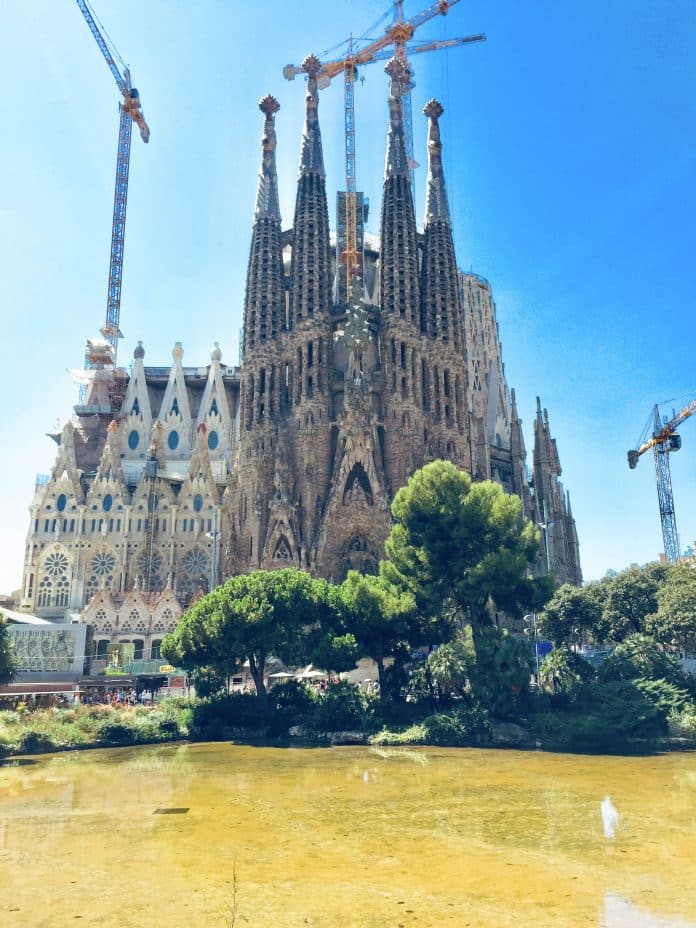Spain has many world heritage sites, but perhaps one of the most amazing is the Sagrada Familia, an old church with some intricate architecture which would be difficult to construct, even today. The Sagrada Familia is perhaps the most visited landmark in Spain.
This church is also noted for still being under construction, as it was never completed in its time. The key architect was Gaudi, and it was his most important work, as well as his most challenging.
Gaudi set up a plan to have the church finished in ten years. Sadly, that didn’t happen. Now it’s been almost 135 years since the first stone was laid, and construction still continues to plan.
The Sagrada Familia is quite unique from the other churches in Spain that visitors can see today. It’s well worth adding a visit during your time spent here. You may even wish to come back a few years from now to see how it’s construction has been progressing.
History of the Sagrada Familia
The Sagrada Familia is located in Barcelona, Catalonia, Spain. It has a Roman Catholic designation. It was officially consecrated in November 2010. It has minor basilica class, so it’s not considered a cathedral, which requires a seat of bishop.
The first stone block was laid down in 1882. The key architect was Antoni Gaudi, famous for many other buildings in Spain. He was a Catalan-style architect that lived from 1852 to 1926. When he passed away at the age of 74 his project was only one quarter complete.
Its architectural style is modernism, with a mix of gothic and art nouveau, a bit different than the usual gothic facades and interiors of many of the other churches in Spain today. When viewed from afar, this church has a whimsical look to it, like it’s from a fantasy film. Yet, the church is real.
The church earned its World Heritage Site Designation in 1969 and 1984 onwards. It’s still in an ongoing phase of construction, and work will continue until approximately 2026 to 2028.
The Sagrada Familia relies largely on donations for its construction in both past and future. Its construction was interrupted by the Spanish Civil War, from 1936 to 1939 and resumed in the 1950s. With the advent of computers, in 2010, construction went a lot faster. However, there still remains many challenges to Gaudi’s original plan. There are supposed to be ten more spires built above the building, each signifying an important biblical figure.
There has been some dispute over the centuries. People were worried it would overshadow Barcelona’s main cathedral. There was also the concern that some of the design work done after Gaudi’s death didn’t exactly follow his plans. There was also a proposal in 2007 to build a rail link beneath the church that could disturb its stability.
Continuing Construction
Another reason that construction still continues on the Sagrada Familia today is due to the damage it has suffered over the years. During the Spanish Civil War, parts of the unfinished church were destroyed. Gaudi’s workshop and some of his models for the church were also destroyed during the war.
Gaudi liked to joke that, “My client is not in a hurry,” in regards to all the delays that the church had seen. Perhaps it was lucky that he passed away prior to the Spanish Civil War and didn’t see that damage done.
Construction of the building today is done by computer-aided design. A CNC milling machine is used, rather than the stone blocks being carved by hand such as happened back in history.

Tips When Visiting the Sagrada Familia
During your visit to the Sagrada Familia, you can see a completed model of the church, and compare it with what’s already been done.
To get to the Sagrada Familia you can take the AVE tunnel in. This was completed in 2013, and is a high-speed train that runs through an underground tunnel beneath Barcelona. The train stop runs right under the church, and has never caused any damage to it, even though that was a significant concern. This stop makes it simple to visit the Sagrada Familia today.
In October 2015, it was announced by the most recent architect that the church was seventy percent completed. The final phase now consists of the last six immense towers. But travellers are still able to visit the church, as you’ll only be excluded from heading into the construction zones.
You are welcome to walk around the church and take photos, but you must visit the interior too. There is an entrance fee which covers most of the construction costs, around $25 million Euros per year. Visitor entrance fees cost from 15 to 20 Euros. You can also purchase online tickets in advance if you wish to avoid lineups and waiting times.
It’s also important to note that during the busy tourist season, from May to October, it’s possible that you won’t be able to access the Sagrada Familia without a reservation. If visiting the Sagrada Familia is on your must-see list, you should purchase your tickets in advance.
If you don’t purchase tickets in advance, you could end up waiting in lineups for hours and hours on end. And this may be right out in the heat of summer.
When purchasing your online tickets you will have three options. One is the regular do-it-yourself tour. There is also the audio tour where you get to listen to fascinating facts through your headphones. And there is also the guided tour where an expert guides you around the church and tells you notable facts.
When selecting your tickets you’ll also have the option of visiting one or both of the towers. If you want an excellent view of the ocean, check out the Passion Tower. If you want a wonderful view of the mountain ranges, visit the Nativity Tower.
When you arrive by train, choose the entrance by the Nativity Facade. This is the region that faces the park and pond. You’ll see an entrance that is set up with black umbrellas. This is the entrance for people who have purchased online tickets, so you can avoid those long lineups.
What’s Accessible to the Public
If you wish to carefully plan your visit here and not miss out on anything, you may be curious as to what exactly is open on site. Besides walking around the exterior, you can access the central nave inside the church. Inside, visitors are also granted access to the Passion and the Nativity towers.
There is also a small Museum located within the Sagrada Familia that you should definitely spend time in. There is also a shop where you can buy postcards and souvenirs.
You should note that in order to access the towers you’ll first need to take an elevator and then go on a short walk to the bridge between the towers. You can simply stop here and view the sites, but you can also access an extremely narrow staircase that has over three hundred steps. This staircase is not for those who are afraid of heights, or people with medical conditions.
What to See On Sight
The original design called for eighteen spires, but to date, there are only eight. More are in the works. You best vantage point to see the spires is from a distance. Each of these corresponds to the eight apostles.
From outside, you can also see grand facades which are located beneath and within some of the spires. These are set in three prominent locations: to the west, and to the east. The south has yet to be finished.
Besides the exterior of the church, the interior is just as spectacular. Inside are featured several brightly coloured stained glass windows. There is also intricate architecture. When you see inside this church you will never think it’s stuffy or boring. There are many colours and lights to brighten every nook and cranny. Not one surface inside is smooth—the designs, paintings, and sculptures were truly brought to life by the artists who made them.
Inside, the church is laid out on a cross-shaped floor plan. There are five aisles. In the center is the central nave vault that expands to forty-five meters in the air. Surrounding it are side nave vaults that reach up as high as thirty meters. The columns are quite large.

The Sagrada Familia has one main organ in the presbytery, and several other organs throughout the building to make up for the shortfall in acoustics.
********************
Plan Your Visit to the Sagrada Familia Today. While you’ll be fascinated by the Sagrada Familia during your visit, you really should learn a bit more about the church before you leave home. Gaudi’s masterpiece is truly amazing. Just imagine how you’ll be able to take the train in and view this truly amazing wonder with your own eyes!












